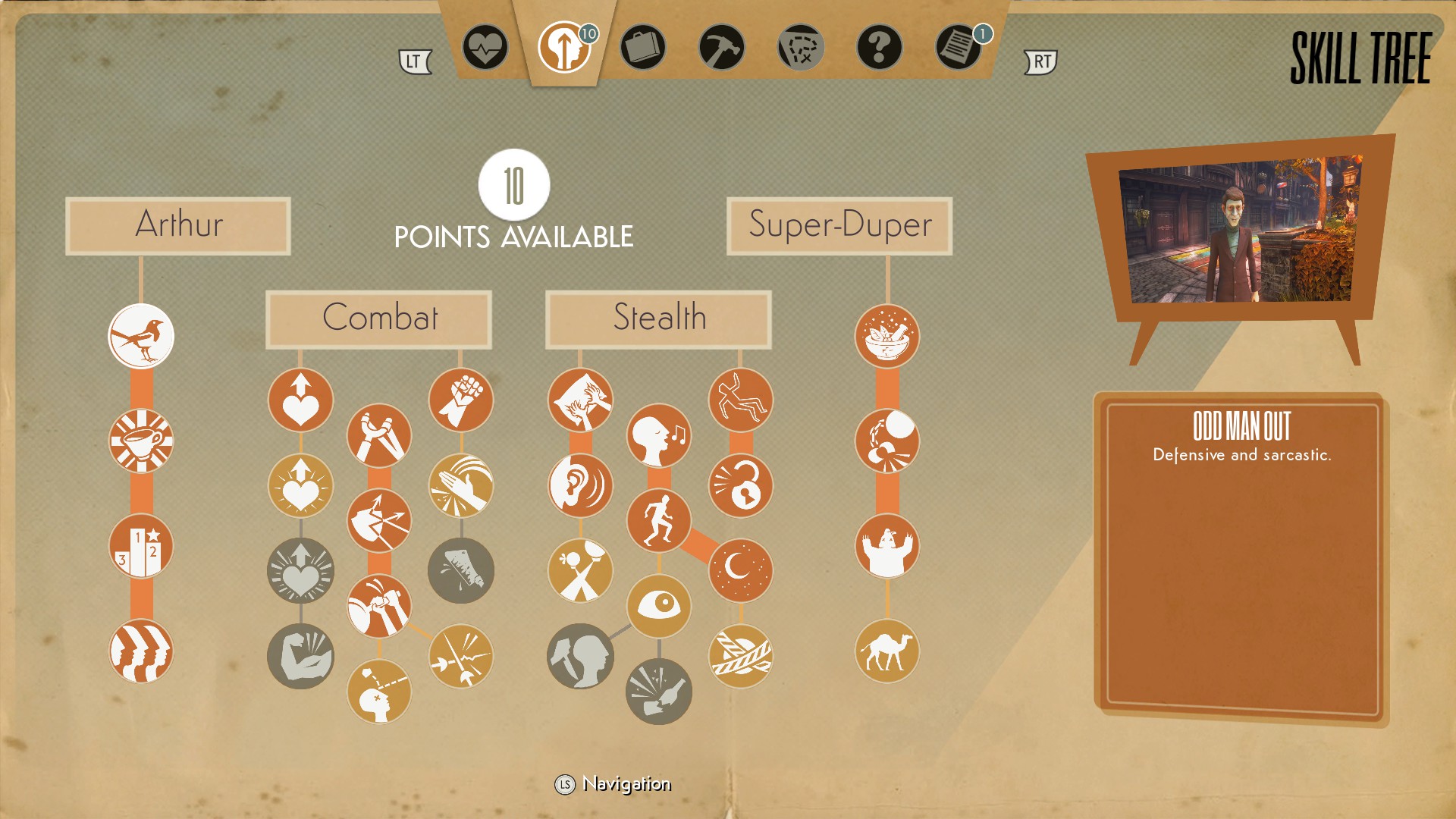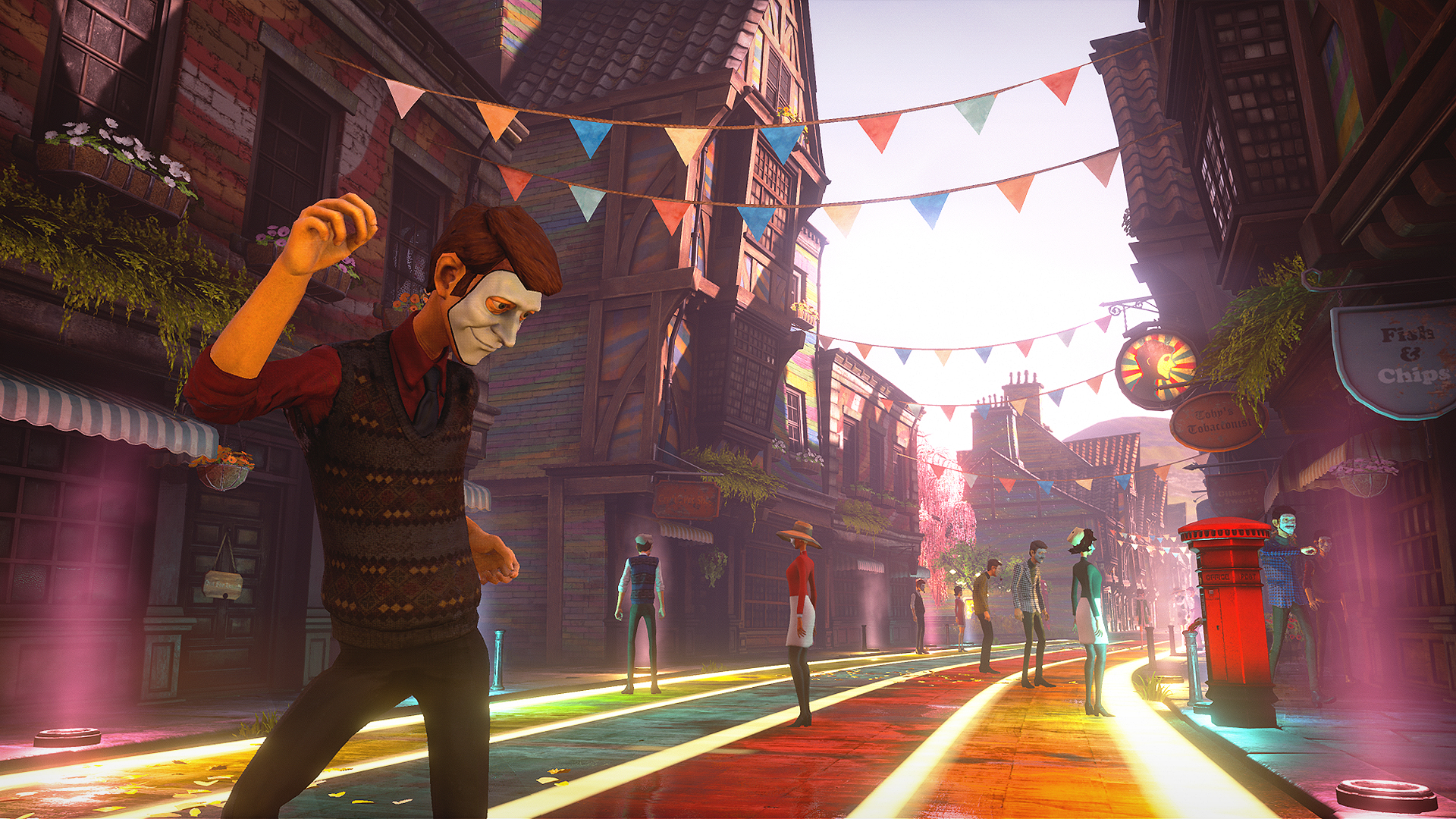We Happy Few Review - More Joy Required
/Ah, Wellington Wells. What a peculiar place to visit. Compulsion Games’ We Happy Few is a crowdfunded project that started off as a survival game, but gradually evolved into a story-focused first-person adventure game that lets players explore an insane, retro-futuristic dystopia through the perspectives of three very different characters. We Happy Few has a great story to tell and a rich world oozing with potential, but all too often, half-baked gameplay elements and occasional bugs hampered my enjoyment of the game’s best moments.
We Happy Few is set in an alternate universe where Germany has occupied Great Britain, and the citizens of Wellington Wells have done something horrible in order to survive certain chemical death. The resulting torment over their actions led them to invent a drug called “Joy” - a suppressant that keeps unhappy memories locked away. In the mid-1960s, it’s clear this drug fractured the community and led to a sticky situation; people who take ‘Joy’ live normal lives in comfortable homes, while those who reject it are left outside to fend for themselves in the Garden District. Wellington Wells’ citizens must be on the drug at all times, and if caught sober, they’re considered ‘Downers’, and are either rehabilitated or removed from the community.
You can't handle the truth!
Our story begins with Arthur, who’s employed as a Censor and is tasked with removing offensive stories from outside newspapers. One piece lands on his desk and triggers a memory of his past, spurring him to reject his ‘Joy’ and to begin to see what the world looks like without its influence. Arthur becomes hell-bent on leaving Wellington Wells, and his odyssey provides a good starting-off point for players to explore the different facets of the techno-dystopia Compulsion Games has created.
The other two playable characters, Sally and Ollie, bring different twists to the gameplay, as well as unique perspectives on this topsy-turvy society, which recalls classics such as Brave New World and Terry Gilliam’s Brazil. We Happy Few’s three storylines are like disparate paint colors that coalesce into a satisfying whole, showcasing a richly-conceived world.
Scattered throughout Wellington Wells’ sizeable expanse, you’ll find varying documents that give players special insights into the people living in this society. Plentiful side-quests also support this world-building, granting opportunities to interact with several odd denizens for rewards such as skill points and crafting blueprints. There is an aspect of random generation to this large playground: in my experience, when I returned to an area with a different character, I observed changed details, although many characters, buildings, and objectives remained largely similar.
Three ways to play, crafting abundance, and inventory blues
Gameplay-wise, each character has their own sets of skills and unique traits. Arthur feels like the jack-of-all-trades, and his skill set focuses on survivability. Sally’s more stealthy, and an adept chemist. Ollie makes use of many explosive gadgets; his guerilla tactics are a significant divergence from the sneaking employed by the other two. I won’t spoil it with details, but an added mechanic exclusive to two of the characters adds more difficulty to the game.
Various gameplay elements are slowly introduced in the first hours. You can craft certain items on the fly from materials picked up in the world. Get ready to collect lots of stuff - item hoarders may go insane. On normal difficulty, healing items aren’t so scarce, and the materials you need to craft a specific gadget or weapon are easy to obtain; I had as many as fifty lockpicks at one point. I got so fed up with constantly picking up stuff that I quit doing it for a few hours. At that point, I’d hoarded so much in the early game that I had enough materials to keep me afloat against any encounter.
It felt like a chore going through all of the items, and the limited number of quick item slots felt insufficient. Just one quick-slot is available for each item category, and to assign it, you’ll have to press a button and cycle through the supplies one by one. It’s frustrating when you inevitably pass the item you were looking for and have to cycle through your hoard again. I actually started bringing fewer items with me in order to reduce the time I spent looking for stuff while in combat.
Act like a fool, get schooled. Dress for success!
Wellington Wells’ authoritarian vibe is well-reflected in its gameplay. If you don’t want to trip any alarms, you’ll need ‘Joy’ in your system. Running, jumping, or doing anything to a Wellie – a citizen who complies with the mandated consumption of Joy – will aggravate them and alert the guards. Some may even attack you. Walking calmly and carrying on is necessary to make the others think that you’re a good order-follower.
Taking too much ‘Joy’ can incur a heavy withdrawal effect, making you more obvious to NPCs. On the flip side, if you’re wearing a clean and flashy outfit, the ‘Joy’-refusing Downers will react aggressively, so getting by them requires you to look as just as ragged as they do. These mechanics are a great touch; they set the tone, keep the player on their toes, and reflect the heavily divided community.
Most of the gameplay involves sneaking to your objective. If things go sideways, you’ll have to rely on melee and throwable weapons. The melee mechanics are pretty straightforward and the skill trees are of minimal impact with regards to how you’ll approach the game. Stealth is the best way to exploit enemy AI. While on the run, going into a hiding spot will fool the guards. Even if they clearly see you entering a dead-end alley with a trash can in the middle, they aren’t given the ability to inspect said hiding spots, so once they give up the chase, you can simply reveal yourself and walk around as if nothing happened.
Some survival mechanics remain in We Happy Few, but they’ve been dialed down from when the game was in Early Access. Players can consume food, water, and rest for a buff. Neglecting these needs does not result in player death. Instead, players simply get a debuff, like reduced total stamina from thirst, which only felt like a slight disadvantage. I neglected my avatar’s hunger several times, and the resultant impact was so tame that, at standard difficulty levels, I’d forget it was there and further starve my poor avatar.
Everything sure does look better with Joy
We Happy Few’s presentation and sound really stand out. The bleak tone and designs when you’re off ‘Joy’ are in complete contrast to the colorful and happy vision of the world on the drug. Upbeat sounds are played, and your character behaves more “positively” with NPCs. And when you come down from the high? To bum a ‘60s parlance, it’s heavy, man, and the sudden switch makes you feel that change. It’s sad to see those drugged up with ‘Joy’ just going about their “happy” lives, ignorant of the reality of their surroundings.
But all throughout my playthrough, I couldn’t shake the feeling that despite the intriguing world, I felt discouraged from playing certain sections of We Happy Few. Some of them add little depth. The feeling is akin to watching a movie you love, but skipping certain parts that aren’t worth your time. Unique character mechanics mitigate the drag somewhat, but this issue is most pronounced at around the midpoint of each playthrough.
We Happy Few’s compelling world and story present a fascinating and telling portrait of an amnesiac post-war dystopia. The combination of tension, exploration, intrigue, and survival made for an strong artistic foundation for Compulsion Games to build their story upon. They’ve created something special here, and I hope they continue to do good story work going forward. We Happy Few’s stealth and combat, on the other hand, needed more work. While the game encourages you to seek out additional playthroughs, they only serve to cast a harsh light on the fundamental mechanics. And that’s a bitter pill to swallow.
7/10
Highlights
Fantastic playable characters with personal stories weave together to form a well-crafted, thought-provoking narrative
Amazing visual and audio designs work in tandem to present the opposing beautiful and bleak sides of its world
Half-baked stealth mechanics lose their appeal early on
Melee combat lacks enough depth to satisfyingly address the amount of content available on release
What I’ve Played
Finished all three story lines
Did a good amount of sidequests and digspots, with plenty to spare
Spent 20+ hours roaming around, all drugged up
[This review is based on a review code provided by Compulsion Games and Evolve PR.]













Assassin’s Creed Shadows greatly blends the classic Assassin’s Creed stealth with the RPG elements of recent entries. Its dynamic world, seasonal changes, and improved stealth mechanics make exploration a joy, but Yasuke’s restrictive gameplay and a half-baked notoriety system hold it back. After 30+ hours, it’s shaping up to be a strong entry, but will it stick the landing?"